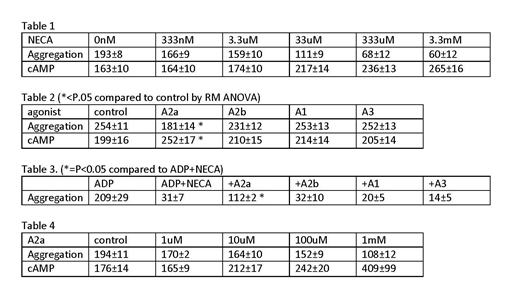Introduction: We have recently shown that severe trauma and hemorrhage lead to inhibition of platelet aggregation and an elevation in cyclic adenosine monophosphate (cAMP). Adenosine is one of the few humoral agents known to stimulate cAMP in platelets. Because adenosine is released from damaged tissue, it may contribute to the platelet dysfunction seen after severe trauma. Platelets have four adenosine receptors (A1, A2a, A2b and A3). These receptors are G-Protein Coupled Receptors and have been proposed to stimulate adenylyl cyclase and increase intracellular cAMP. Although studies have shown that stimulate A2a can inhibit platelet aggregation and elevate cAMP, there is little data elucidating the function of the other receptors.
Objective: Define which adenosine receptors affects platelet aggregation and cAMP production.
Methods: Platelet-rich plasma (PRP) was isolated from whole blood of human volunteers, and centrifuged at 200g for 10min. Light transmission aggregometry was performed using a plate reader (Synergy Neo2 Multimode Reader, BioTek) with constant agitation. PRP was stimulated with adenosine diphosphate (ADP) with or without various adenosine agonists or antagonists, including the non-metabolizable adenosine agonist 5-(N-ethyl-carboxamido) adenosine (NECA), antagonists to receptors A1 (DPCPX), A2a (Sch 58261), A2b (GS 6201) and A3 (MRS 1220), or agonists for A2a (CGS 21680) A2b (BAY 60-6583) or agonist A1 (CCPA), A2a (CGS 21680), A2b (Bay 60-6583), A3 (2-Cl-IB-Meca). Cyclic AMP was extracted from 100ul of PRP after adding 1ml of EtOH, 10mM ammonium formate, with 10ug/ml cGMP-Br as an internal control. Samples were centrifuged at 20K g for 10min, and supernatant dried. Samples were brought up in 200ul of 0.1% formic acid for analysis by Reverse Phase liquid chromatography/ Tandem Mass Spectroscopy (Quantiva, ThrermoFisher). N-8/group.
Results: Adenosine diphosphate (100uM) leads to platelet aggregation (change in mAbsorbance units, Table 1). The adenosine agonist NECA inhibited aggregation to ADP and elevated cAMP in a dose dependent manner (pg/ml per 1000 plt, Table 1). Platelet aggregation was inhibited and cAMP was elevated after stimulation with agonists for adenosine receptor A2a agonist, but not A1, A2b, or A3 (Table 2). Antagonists for A2a, but not A1, A2b, A3, blocked NECA inhibition of ADP aggregation (Table 3). Agonist for adenosine receptor A2a inhibited the ADP-induced aggregation and elevated cAMP in a dose response manner (Table 4).
Discussion: Adenosine inhibits platelet aggregation to ADP. The mechanism appears to be due to elevation in intracellular cAMP, and works through the A2a receptor. These data suggest that the A2a receptor could be potential target for a resuscitation strategy that could attenuate or prevent platelet dysfunction after trauma by preventing stimulation of adenylate cyclase and synthesis of cAMP. This study was funded by the US Army medical Research and Development Command.
No relevant conflicts of interest to declare.
Author notes
Asterisk with author names denotes non-ASH members.


This feature is available to Subscribers Only
Sign In or Create an Account Close Modal